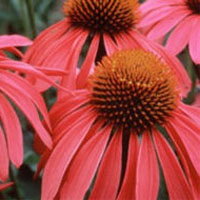Fit and Fast Recipes
Echinacea
 © Steven Foster
© Steven FosterParts Used & Where Grown
Echinacea is a wildflower native to North America. While echinacea continues to grow and is harvested from the wild, the majority used for herbal supplements comes from cultivated plants. The root and/or the above-ground part of the plant during the flowering growth phase are used in herbal medicine.
- Reliable and relatively consistent scientific data showing a substantial health benefit.
- Contradictory, insufficient, or preliminary studies suggesting a health benefit or minimal health benefit.
- For an herb, supported by traditional use but minimal or no scientific evidence. For a supplement, little scientific support.
Our proprietary “Star-Rating” system was developed to help you easily understand the amount of scientific support behind each supplement in relation to a specific health condition. While there is no way to predict whether a vitamin, mineral, or herb will successfully treat or prevent associated health conditions, our unique ratings tell you how well these supplements are understood by the medical community, and whether studies have found them to be effective for other people.
For over a decade, our team has combed through thousands of research articles published in reputable journals. To help you make educated decisions, and to better understand controversial or confusing supplements, our medical experts have digested the science into these three easy-to-follow ratings. We hope this provides you with a helpful resource to make informed decisions towards your health and well-being.
This supplement has been used in connection with the following health conditions:
| Used for | Amount | Why |
|---|---|---|
Common Cold | 3 to 5 ml of liquid herbal extracts every two hours, or 300 to 600 mg of powdered herb three times daily, or five to six cups of tea daily | At the first sign of a cold, taking immune-stimulating echinacea as a juice or tincture may make colds less severe. |
Gingivitis (Caraway, Chamomile, Clove Oil, Menthol, Molmol, Peppermint, Sage) | 0.5 ml in half a glass of water three times per day swished slowly in the mouth before spitting out | A mouthwash containing sage oil, peppermint oil, menthol, chamomile tincture, expressed juice from echinacea, myrrh tincture, clove oil, and caraway oil has been used successfully to treat gingivitis. |
Immune Function | 3 to 5 ml of liquid extract three times per day | Studies have found that echinacea stimulates the function of a variety of immune cells, particularly natural killer cells. Taking it appears to speed recovery from the common cold. |
Infection | 3 to 5 ml of liquid herbal extracts every two hours, or 300 to 600 mg of powdered herb three times per day, or 5 to 6 cups of tea daily | Echinacea is both immune supportive and antimicrobial. |
Influenza | 3 to 5 ml of liquid formulas or 300 mg of powdered root supplements three times per day | Taking echinacea may help clear flu symptoms faster. |
Bronchitis | Refer to label instructions | Echinacea is an immune-stimulating herb that is widely used by herbalists for people with acute respiratory infections. |
Canker Sores | Refer to label instructions | The antiviral, immune-enhancing, and wound-healing properties of echinacea may make this herb a reasonable choice for canker sores. |
Chronic Candidiasis | Refer to label instructions | The fresh-pressed juice of Echinacea purpurea has been shown to help prevent recurring yeast infections in one trial. |
Cold Sores | Refer to label instructions | In traditional herbal medicine, tinctures of various herbs including echinacea have been applied topically to herpes outbreaks in order to promote healing. |
Ear Infections | Refer to label instructions | Children with recurrent ear infections may benefit from taking echinacea, as it has been reported to support healthy immune function. |
Gingivitis | Refer to label instructions | Echinacea provides anti-inflammatory and antimicrobial actions critical to successfully treating gingivitis. |
HIV and AIDS Support | Refer to label instructions | Supplementing with echinacea may increase immune activity against HIV. |
Vaginitis | Refer to label instructions | Echinacea is antibacterial and known to improve resistance to infection. |
Wound Healing | Refer to label instructions | Echinacea is used among European practitioners of herbal medicine to promote wound healing. |
Yeast Infection | Refer to label instructions | Echinacea, which enhances immune function, has been used successfully to treat yeast infections. |
Traditional Use (May Not Be Supported by Scientific Studies)
Echinacea was used by Native Americans for a variety of conditions, including venomous bites and other external wounds. It was introduced into U.S. medical practice in 1887 and was touted for use in conditions ranging from colds to syphilis. Modern research started in the 1930s in Germany.
Copyright © 2025 TraceGains, Inc. All rights reserved.
Learn more about TraceGains, the company.
The information presented by TraceGains is for informational purposes only. It is based on scientific studies (human, animal, or in vitro), clinical experience, or traditional usage as cited in each article. The results reported may not necessarily occur in all individuals. Self-treatment is not recommended for life-threatening conditions that require medical treatment under a doctor's care. For many of the conditions discussed, treatment with prescription or over the counter medication is also available. Consult your doctor, practitioner, and/or pharmacist for any health problem and before using any supplements or before making any changes in prescribed medications. Information expires December 2025.










